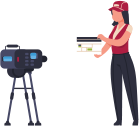Film language
Activity – using film language to tell a story

Access 'Video 2 – Using film language to tell a story’ and respond to the questions below.
Glossary
- Big print
-
text in a script that describes what can be seen and heard (stage directions, entry and exit of characters on-screen, movement and dance, characters using props, sound effects, feelings and attitudes)
- Celtx
-
software to help with script writing and pre-production
- Mise en scene
-
props, colour and items in a filmed scene that communicate feeling, such as costume, make-up, performance and non-verbal expression
- Props
-
an object or extra piece of clothing used by a character when filming
- Colour palette
-
the variety of colours to use for a film (for example makeup, props and costumes)
- Cinematographer
-
crew member who designs camera angles, lighting, special effects and mise en scene
- DOP
-
director of photography; cinematographer
- Pre-production
-
preparation before shooting a film
- HOD (head/s of department)
-
person in charge, such as wardrobe, hair or make-up
- Big rocks
-
essential elements of pre-production, such as auditions, cast, rehearsal days, location, HOD, creative brief, shot list, the unit and schedule (3 drafts)
- 1st Assistant Director (1AD)
-
plans and runs the filming portion of a film project
Questions
- Consider 4 different roles in the filmmaking process, such as the director, costume designer, actors and sound designer. How do each of the roles contribute to creating meaning in short films?
- Explain why it is important for all team members to share the same vision and intentions for the film.
- During the post-production phase, why is feedback important?